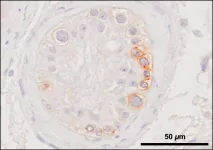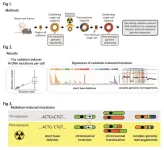(Press-News.org) The Amazon rainforest could approach a tipping point, which could lead to a large-scale collapse with serious implications for the global climate system. A new Nature study by an international research team including scientists from the Potsdam Institute for Climate Impact research (PIK) reveals that up to 47 percent of the Amazonian forest is threatened and identifies climatic and land-use thresholds that should not be breached to keep the Amazon resilient.
“The Southeastern Amazon has already shifted from a carbon sink to a source –meaning that the current amount of human pressure is too high for the region to maintain its status as a rainforest over the long term. But the problem doesn't stop there. Since rainforests enrich the air with a lot of moisture which forms the basis of precipitation in the west and south of the continent, losing forest in one place can lead to losing forest in another in a self-propelling feedback loop or simply ‘tipping’”, states PIK scientist Boris Sakschewski, one of the authors of the study.
Up to 47 percent of the Amazon rainforest threatened by droughts and fires
Recent stress from increased temperatures, droughts, deforestation, and fires even in central and remote parts is weakening the Amazon's natural resilience mechanisms, pushing this system towards a critical threshold. The study finds that by the year 2050, 10-47 percent of the Amazonian forests will be threatened by increasing disturbances, risking to cross a tipping point.
Based on a large body of scientific results, the researchers identify five critical drivers connected to this tipping point: global warming, annual rainfall amounts, the intensity of rainfall seasonality, dry season length, and accumulated deforestation. For each of these drivers they suggest safe boundaries to keep the Amazon resilient.
“We found for example that for mean annual rainfall below 1000 mm per year, the Amazon rainforest cannot exist. However, below 1800 mm per year, abrupt transitions from rainforest to a Savanna-like vegetation become possible. This can be triggered by individual droughts or forest fires, which both have become more frequent and more severe in recent years”, states Da Nian, scientist at PIK and also author of the study.
The impact of forest loss does not stop at the borders of the Amazon. The moisture transported via Amazons´ so called “flying rivers” is an critical part of the South American Monsoon and hence essential for rainfall in vast parts of the continent. Moreover, the Amazon as a whole stores carbon equivalent to 15-20 years of current human CO2 emissions. Amazon forest loss therefore further drives global warming and intensifies the consequences.
"Greenhouse gas emissions and deforestation have to end"
The study also analyses examples of disturbed forests in various parts of the Amazon to understand what could happen to the ecosystem. In some cases, the forest may recover in the future, but still remain trapped in a degraded state, dominated by opportunistic plants, such as lianas or bamboos. In other cases, the forest does not recover anymore, and remains trapped in an open-canopy, flammable state. The expansion of open, flammable ecosystems throughout the core of the Amazon forest is particularly concerning because they can spread fires to adjacent forests.
“To maintain the Amazon forest within safe boundaries, local and global efforts must be combined. Deforestation and forest degradation have to end and restoration has to expand. Moreover, much more needs to be done to stop greenhouse-gas emissions worldwide”, concludes co-author Niklas Boers, leader of the Future Lab 'Artificial Intelligence in the Anthropocene' at PIK and professor of Earth System Modelling at the Technical University of Munich.
Article: Bernardo M. Flores, Encarni Montoya, Boris Sakschewski, Nathália Nascimento, Arie Staal, Richard A. Betts, Carolina Levis, David M. Lapola, Adriane Esquível-Muelbert, Catarina Jakovac, Carlos A. Nobre, Rafael S. Oliveira, Laura S. Borma, Da Nian, Niklas Boers,, Susanna B. Hecht, Hans ter Steege, Julia Arieira, Isabella L. Lucas, Erika 6 Berenguer, José A. Marengo, Luciana V. Gatti, Caio R. C. Mattos & Marina Hirota (2024): Critical transitions in the Amazon forest system. Nature. [DOI: 10.1038/s41586-023-06970-0]
END
Amazon rainforest at the threshold: loss of forest worsens climate change
The Amazon rainforest could approach a tipping point, which could lead to a large-scale collapse with serious implications for the global climate system
2024-02-14
ELSE PRESS RELEASES FROM THIS DATE:
Researchers uncover mechanisms behind enigmatic shapes of nuclei
2024-02-14
Nearly 150 years ago, scientists discovered that specialized blood cells serve a vital role in immune system protection against infection and illness.
Certain groups of these white blood cells, now known as neutrophils, feature a nucleus that is structured strikingly different than most nuclei. The majority of cells feature round- or oval-shaped nuclei that are rigid, but neutrophils differ in that their nuclei adopt multiple lobular structures akin to that of flower petal arrangements.
These unique nuclear shapes permit neutrophils to travel all over the body to identify and combat invading ...
Online images may be turning back the clock on gender bias
2024-02-14
A picture is worth a thousand words, as the saying goes, and research has shown that the human brain does indeed better retain information from images than from text. These days, we are taking in more visual content than ever as we peruse picture-packed news sites and social media platforms.
And much of that visual content, according to new Berkeley Haas research published in the journal Nature, is reinforcing powerful gender stereotypes.
Through a series of experiments, observations, and the help of large language models, professors Douglas Guilbeault and Solène Delecourt found that female and male gender associations are more extreme among Google Images than within text ...
Smoking has long-term effects on the immune system
2024-02-14
Like other factors such as age, sex and genetics, smoking has a major impact on immune responses. This is the finding recently made by a team of scientists at the Institut Pasteur using the Milieu Intérieur cohort of 1,000 healthy volunteers, established to understand variability in immune responses. In addition to its short-term impact on immunity, smoking also has long-term consequences. For many years after they have quit the habit, smokers are left with effects on some of their bodies' defense mechanisms acquired while smoking. These findings, which for the first time reveal a long-term memory of the effects of smoking ...
Male fertility gene discovery reveals path to success for sperm
2024-02-14
Discovery of a pair of genes that work in perfect harmony to protect male fertility, could provide new insights into some unexplained cases of the most severe form of infertility, research suggests.
Genetic analysis of cases of male infertility revealed that rare mutations in a gene, known as SPOCD1, disrupts the formation of healthy sperm during the earliest stages of their development.
The gene was also found to work in partnership with a previously unknown gene, C19orf84, to protect the early-stage precursors to sperm, known as germ cells, from damage.
The discovery of the essential role of these ...
Genome sequencing unveils mutational impacts of radiation on mammalian cells
2024-02-14
Recent release of the waste water from Japan's Fukushima nuclear disaster stirred apprehension regarding the health implications of radiation exposure. Classified as a Group 1 carcinogen, ionizing radiation has long been associated with various cancers and genetic disorders, as evidenced by survivors and descendants of atomic bombings and the Chernobyl disaster. Despite much smaller amount, we remain consistently exposed to low levels of radiation in everyday life and medical procedures.
Radiation, whether in the form of high-energy particles or electromagnetic waves, is conventionally known to break our cellular DNA, leading to cancer ...
WashU awarded up to $20 million to create portable device to scan for eye diseases
2024-02-14
In the United States, more than one-fourth of adults over age 40 have an eye disease, including glaucoma, cataracts or age-related macular degeneration, or a chronic health condition that affects the eyes, such as diabetic retinopathy. These conditions are a strain on an individual’s health as well as on the health-care system, yet early diagnosis and management can help to prevent more than 90% of severe vision loss.
Chao Zhou, a professor of biomedical engineering in the McKelvey School of Engineering at Washington University in St. Louis, has been working to improve optical coherence tomography (OCT) systems that can conduct high-resolution imaging of the ...
New understanding of avian eggshell attachment – implications for medical procedures and egg industry
2024-02-14
Athletes often suffer injuries to ligaments in their knees, particularly to the anterior cruciate ligament or ACL. While surgery to replace these torn ligaments is becoming increasingly common around the world it often needs to be repeated. That’s because it has proved challenging to anchor fibrous, soft and wet ligament grafting material into hard bone.
Now, McGill University researchers have new information from the eggshell membrane in chicken eggs that could help change this picture thanks to the potential it offers for improvements in tissue engineering ...
HHMI opens National Competition for Freeman Hrabowski Scholars Program
2024-02-14
Today, the Howard Hughes Medical Institute (HHMI) opened a national competition to select up to 30 early career faculty in science to join the 2025 cohort of the Freeman Hrabowski Scholars Program.
Freeman Hrabowski Scholars are outstanding basic researchers, including physician-scientists, who have strong potential to become leaders in their fields. Scholars are committed to advancing diversity, equity, and inclusion through their mentoring efforts and understanding of systemic exclusion and marginalization in science of trainees from different backgrounds. While pursuing excellence in their own research, Scholars work to create an inclusive lab climate ...
Study: New treatment method helps reduce suicide among military and veterans
2024-02-14
COLUMBUS, Ohio – Post traumatic stress disorder (PTSD) is common among U.S. military veterans. It’s also linked with higher risk of suicidal thoughts and behaviors.
A study led by researchers with The Ohio State University Wexner Medical Center and College of Medicine found that crisis response planning (CRP) can help. This brief intervention quickly reduced suicidal thoughts among patients receiving daily therapy for two weeks for PTSD. This type of therapy is called “cognitive processing therapy,” or CPT.
“This study shows that crisis response planning can rapidly reduce suicide risk. It is the first study to prove this technique works when ...
The CRISPR Journal announces the publication of its February 2024 issue
2024-02-14
The CRISPR Journal announces the publication of its February 2024 issue. The CRISPR Journal is devoted to publishing outstanding research in CRISPR biology, technology, and genome editing. Chief Editor is Professor Rodolphe Barrangou, PhD (North Carolina State University); Executive Editor is Dr. Kevin Davies. For full-text copies of articles or to arrange interviews with the editors, authors, or members of the editorial board, contact Kathryn Ryan at the Publisher.
1. Warrior spirit: An interview with sickle cell pioneer Victoria Gray,
The gene editing world and the sickle cell disease (SCD) ...
LAST 30 PRESS RELEASES:
Injectable breast ‘implant’ offers alternative to traditional surgeries
Neuroscientists devise formulas to measure multilingualism
New prostate cancer trial seeks to reduce toxicity without sacrificing efficacy
Geometry shapes life
A CRISPR screen reveals many previously unrecognized genes required for brain development and a new neurodevelopmental disorder
Hot flush treatment has anti-breast cancer activity, study finds
Securing AI systems against growing cybersecurity threats
Longest observation of an active solar region
Why nail-biting, procrastination and other self-sabotaging behaviors are rooted in survival instincts
Regional variations in mechanical properties of porcine leptomeninges
Artificial empathy in therapy and healthcare: advancements in interpersonal interaction technologies
Why some brains switch gears more efficiently than others
UVA’s Jundong Li wins ICDM’S 2025 Tao Li Award for data mining, machine learning
UVA’s low-power, high-performance computer power player Mircea Stan earns National Academy of Inventors fellowship
Not playing by the rules: USU researcher explores filamentous algae dynamics in rivers
Do our body clocks influence our risk of dementia?
Anthropologists offer new evidence of bipedalism in long-debated fossil discovery
Safer receipt paper from wood
Dosage-sensitive genes suggest no whole-genome duplications in ancestral angiosperm
First ancient human herpesvirus genomes document their deep history with humans
Why Some Bacteria Survive Antibiotics and How to Stop Them - New study reveals that bacteria can survive antibiotic treatment through two fundamentally different “shutdown modes”
UCLA study links scar healing to dangerous placenta condition
CHANGE-seq-BE finds off-target changes in the genome from base editors
The Journal of Nuclear Medicine Ahead-of-Print Tip Sheet: January 2, 2026
Delayed or absent first dose of measles, mumps, and rubella vaccination
Trends in US preterm birth rates by household income and race and ethnicity
Study identifies potential biomarker linked to progression and brain inflammation in multiple sclerosis
Many mothers in Norway do not show up for postnatal check-ups
Researchers want to find out why quick clay is so unstable
Superradiant spins show teamwork at the quantum scale
[Press-News.org] Amazon rainforest at the threshold: loss of forest worsens climate changeThe Amazon rainforest could approach a tipping point, which could lead to a large-scale collapse with serious implications for the global climate system






